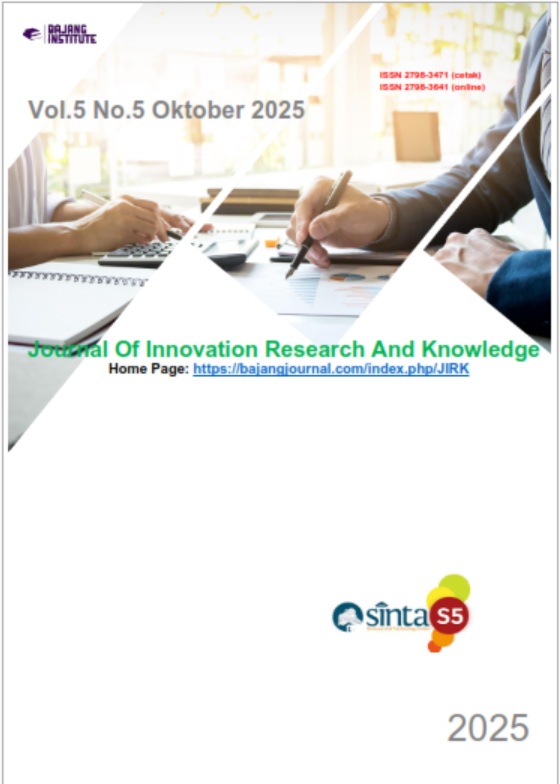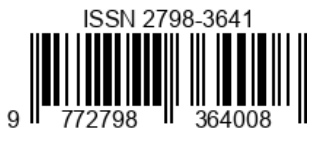KEPERCAYAAN DIRI DENGAN KESIAPAN KERJA SISWA KELAS XII DI SMKN X SALATIGA
DOI:
https://doi.org/10.53625/jirk.v5i5.11470Keywords:
Self-Confidence, Work Readiness, Vocational Students, SalatigaAbstract
Work readiness is an important aspect for vocational high school (SMK) students in facing the demands of the workforce, and one psychological factor that contributes to it is self-confidence, which helps students adapt, make decisions, and confront professional challenges. This study aimed to examine the relationship between self-confidence and work readiness among twelfth-grade students at SMKN X in Salatiga using a quantitative correlational approach. The study involved 100 students selected by cluster sampling. The research instruments included a work readiness scale based on aspects from Caballero et al. (2011) and a self-confidence scale based on the theory of Lauster (2012). Data were analyzed using Pearson’s correlation. The results showed a positive and significant relationship between self-confidence and work readiness (r = 0,670; p < 0,001), indicating that higher levels of self-confidence are associated with higher levels of work readiness. These findings underscore the importance of school programs focused on enhancing students’ self-confidence to support the work readiness of SMK graduates
References
Abdelwahed, N. A. A., & Doghan, M. A. A. (2023). Developing employee productivity and performance through work engagement and organizational factors in an educational society. Societies, 13(3). https://doi.org/10.3390/soc13030065
Abelha, M., Fernandes, S., Mesquita, D., Seabra, F., & Ferreira-Oliveira, A. T. (2020). Graduate employability and competence development in higher education: A systematic literature review using PRISMA. Sustainability (Switzerland), 12(15). https://doi.org/10.3390/su12155900
Aiken, L. R. (1980). Educational and psychological measurement. Educational and Psychological Measurement, 40(4), 955–959. https://doi.org/10.1177/001316448004000419
Akbari, O., & Sahibzada, J. (2020). Students’ self-confidence and its impacts on their learning process. American International Journal of Social Science Research, 5(1), 1–12. https://doi.org/10.46281/aijssr.v5i1.462
Amri, S. (2018). Pengaruh kepercayaan diri (self-confidence) berbasis ekstrakurikuler pramuka terhadap prestasi belajar matematika siswa SMA Negeri 6 Kota Bengkulu. Jurnal Pendidikan Matematika Raflesia, 3(2). https://ejournal.unib.ac.id/index.php/jpmr
Bukit, B., Malusa, T., & Rahmat, A. (2017). Pengembangan sumber daya manusia. ZAHR Publishing.
Caballero, C. L., Walker, A., & Fuller-Tyszkiewicz, M. (2011). The Work Readiness Scale (WRS): Developing a measure to assess work readiness in college graduates. Journal of Teaching and Learning for Graduate Employability, 2(1), 41–54. https://doi.org/10.21153/jtlge2011vol2no1art552
Creswell, J. W. (2014). Research design: Qualitative, quantitative, and mixed methods approaches (4th ed.). Thousand Oaks, CA: SAGE Publications.
Ghufron, N., & Risnawita, R. (2010). Teori-teori psikologi. Ar-Ruzz Media.
Hillage, J., & Pollard, E. (1999). Employability: Developing a framework for policy analysis. Department for Education and Employment.
Ibourk, A., & El Aynaoui, K. (2023). Career trajectories of higher education graduates: Impact of soft skills. Economies, 11(7), 1–16. https://doi.org/10.3390/economies11070198
Khairunnisa, D., Widiana, H. S., & Suyono, H. (2022). Self-confidence and psychological well-being on employability of vocational high school students. Jurnal Psikologi, 11(1), 13–21. https://doi.org/10.30872/psikostudia
Knight, P., & Yorke, M. (2004). Learning, curriculum and employability in higher education. RoutledgeFalmer.
Laima Oge, A., Rachman, D., & Istati, M. (2022). The effect of self-confidence on the work readiness of class XII students of SMKN 1 Banjarbaru. Jurnal Pelayanan Bimbingan dan Konseling, 5(1), 1–8. https://ppjp.ulm.ac.id/journals/index.php/jpbk/index
Lauster, P. (2012). Tes Kepribadian (D.H. Gulo, Penerj.). PT Bumi Aksara.
Maulina, M., & Yoenanto, N. H. (2022). Optimalisasi link and match sebagai upaya relevansi SMK dengan dunia usaha dan dunia industri (DUDI). Jurnal Akuntabilitas Manajemen Pendidikan, 10(1), 28-37. https://doi.org/10.21831/jamp.v10i1.48008
Muspawi, M. ., & Lestari, A. . (2020). MEMBANGUN KESIAPAN KERJA CALON TENAGA KERJA. Jurnal Literasiologi, 4(1). https://doi.org/10.47783/literasiologi.v4i1.138
Novita, L., & Sumiarsih. (2021). Pengaruh konsep diri terhadap kepercayaan diri siswa. Jurnal Pendidikan dan Pengajaran Guru Sekolah Dasar (JPPGuseda), 4(2), 92–96. http://journal.unpak.ac.id/index.php/jppguseda
Restu Naim, H., Arlizon, R., Yakub, E., & Studi Bimbingan dan Konseling, P. (2017). Perbedaan Kepercayaan Diri Siswa yang Aktif Organisasi dengan Siswa yang Tidak Aktif Organisasi. Jurnal Online Mahasiswa Fakultas Keguruan dan Ilmu Pendidikan Universitas Riau, 4(2), 1-14. https://www.neliti.com/publications/204947/perbedaan-kepercayaan-diri-siswa-yang-aktif-organisasi-dengan-siswa-yang-tidak-a
Ristiani, & Lusianingrum, F. (2022). The effect of self-confidence on job readiness. Journal of Applied Business, Taxation and Economics Research, 1(5), 450–461. https://doi.org/10.54408/jabter.v1i5.89
Riyanto, F., & Wulandari, F. (2024). The effect of self-efficacy, job training, and job interest on work readiness of Solo Raya students. Proceeding International Conference on Economic and Social Sciences, 2, 836–849. Retrieved from https://icess.uin-suska.ac.id/index.php/1/article/view/175
Sari, A. (2022). Hubungan dukungan sosial dengan self-confidence pada remaja putri dalam mengikuti pelajaran di Madrasah Aliyah Al Khoirot Pagelaran Kabupaten Malang [Skripsi, Universitas Islam Negeri Maulana Malik Ibrahim Malang]. Repositori Universitas Islam Negeri Maulana Malik Ibrahim Malang. http://etheses.uin-malang.ac.id/34353/1/17410207.pdf
Siddique, C. M., Siddique, H. F., & Siddique, S. U. (2020). Linking authoritarian leadership to employee organizational embeddedness, LMX and performance in a high-power distance culture: A mediation-moderated analysis. Journal of Strategy and Management, 13(3), 393–411. https://doi.org/10.1108/jsma-10-2019-0185
Sugiyono. (2018). Metode Penelitian kuantitatif, Kualitatif, dan R&D. Alfabeta.
Wardani, F. K., Isnain, A. N., Alifah, A. N., Khasanah, P. U., Nabila, F. A., Ika, S. P., Astikawati, H., & Husna, A. N. (2021). The construction of Work Readiness Scale. The 14th University Research Colloquium: Seri Sosial, Seni, Agama, dan Humaniora, 78–87. Sekolah Tinggi Ilmu Ekonomi Muhammadiyah Cilacap. https://www.repository.urecol.org/index.php/proceeding/article/download/1774/1740/3480
Wijayanti, A., & Kinayung, D. (2022). Kepercayaan diri dan dukungan sosial dengan kemandirian pada mahasiswa perantauan. EMPATHY: Jurnal Fakultas Psikologi, 5(2), 1–15. https://doi.org/10.26555/empathy.v4i1
Yasinta, S., & Aminuddin Irfani. (2022). Pengaruh Efikasi Diri terhadap Kesiapan Kerja Mahasiswa Akhir Program Studi Manajemen Angkatan 2018 Fakultas Ekonomi dan Bisnis Universitas Islam Bandung. Bandung Conference Series: Business and Management, 2(2). https://doi.org/10.29313/bcsbm.v2i2.3512
Peraturan Pemerintah Republik Indonesia Nomor 29 Tahun 1990: Pendidikan Menengah.
Badan Pusat Statistik. (2025, 6 Februari). Tingkat pengangguran terbuka berdasarkan tingkat pendidikan (Tabel statistik). BPS. https://www.bps.go.id/id/statistics-table/2/MTE3OSMy/tingkat-pengangguran-terbuka-berdasarkan-tingkat-pendidikan.html
Kementerian Pendidikan, Kebudayaan, Riset, dan Teknologi Republik Indonesia. (2023). Panduan pengembangan bakat dan minat melalui pemilihan konsentrasi keahlian dan ekstrakurikuler. https://kurikulum.kemdikbud.go.id/file/Buku_Panduan_Pengembangan_Bakat_&_Minat.pdf
Republika. (2023, Februari 22). Kadin: Masih banyak lulusan SMK belum siap kerja. Republika. https://ekonomi.republika.co.id/berita/rqgms9349/kadin-masih-banyak-lulusan-smk-belum-siap-kerja















